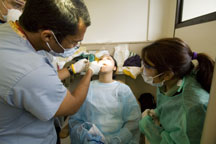

Community-based Rotation Logistics

Assignment When Clinical Competence Achieved
Optimal Duration of Rotations
Faculty Appointments
Faculty’s Role: Both Student Supervision and Patient Care
Credit Towards Graduation
Program and Student Performance Evaluation
Assignment When Clinical Competence Achieved
Each school needs to determine when a senior student is ready to be assigned to patient-centered community practice where they will receive less supervision than in dental school clinics. Since students learn and develop clinical skills, judgment, and social maturity at different rates, they will not all be ready for their community experiences at the same time. In fact, a few senior students may never be ready for a community rotation. The process used to define clinical competence should be formal and involve faculty from multiple departments.
To assist in supervising students, community faculty should be sent profiles of students, including their strengths and weaknesses. This will be of great value to preceptors in assigning patients to students and in deciding the appropriate level of supervision.
Optimal Duration of Rotations
Rotations are the most effective when students are assigned to a community facility for at least a four-week block of time or for one or two days per week for several months.
Longer rotations give both faculty and students time to grow comfortable with each other and learn to work together productively and efficiently. As a rule of thumb, the average rotation should last for 20 or more consecutive work days or an equivalent length of time for one or two days a week over several months.
Students also benefit from assignment to two or three different clinics and practices rather than to the same facility for the entire 60 days. Treating different mixes of patients and having several preceptors broadens and strengthens students’ knowledge and skills.
Additionally, students benefit when didactic instruction continues during rotations. If the school and community sites are geographically close enough, as in large cities, students can attend early morning lectures at the dental school and still be at their community assignments in time to see a full morning of patients. When students are too far from the school to return conveniently for didactic instruction, schools can consider distance learning methods such as teleconferences and computer-based modes of instruction such as chat groups and CD-ROMs.
Faculty Appointments
All community-based faculty should receive formal appointments in the dental school. This appointment is necessary to provide them liability coverage under the school’s malpractice policy and to give them the rights and privileges of the full-time faculty in terms of access to university and school resources such as libraries, computer centers, continuing education courses, etc. To the extent possible, community faculty should be involved in school activities including governance, social events, and formal participation in faculty committees that direct community-based education programs. Schools should make a special effort to breakdown any “social” walls that may exist between community and school-based faculty.
Faculty’s Role: Both Student Supervision and Patient Care
Community faculty who supervise students should have a formal orientation program to acquaint them with program objectives and operations and should be calibrated with the full-time faculty based at the dental school in terms of evaluating student performance. Community faculty should also receive an operations manual that clearly describes program objectives, operations, and student evaluation and provides instructions on how to deal with problems that may arise. This orientation and training program should take place at least annually.
Under the traditional dental school teaching model, faculty supervise five to seven students. This involves responding to student requests to check their work as they treat patients. This teaching model does not allow faculty to treat their own patients as they supervise students.
When students are assigned to a patient-centered community clinic or practice, this model of precepting is incompatible with the primary goals of the facility. Specifically, there is a significant drop in the number of patients treated and revenues generated, if experienced dentists spend their time supervising students.
Therefore, it is important that community faculty continue to treat their own patients while they supervise students. This arrangement has been shown to be successful if the following conditions are met:
- Community faculty supervise one or, at most, two students
- Senior students are clinically competent (as previously defined) and do not require the level of supervision of third-year students
- Patients selected for students to treat have oral conditions that can be managed by senior dental students.
This model of clinical teaching has many advantages:
- Enhance educational experiences for students who have close contact with faculty
- A greater number of patients receive care
- Higher revenues for the dental facilities
It also prepares clinically competent senior students for patient-centered residencies or practices, and preceptors provide excellent role models for students as they learn to manage patients, staff, and practices.
Credit Towards Graduation
Many schools require students to complete a specific number of procedures for graduation. Clearly, if students spend 60 or more days in community rotations, they must receive credit for the services provided. Otherwise, students will be reluctant to participate in the community rotations.
Program and Student Performance Evaluation
Schools must establish formal systems for evaluating the performance of their community educational programs. This system needs to obtain data from preceptors, students, and faculty directors periodically, and the data should guide improvements to the program. The evaluation system must be clearly specified in writing so that all program participants understand the system and their roles in data collection and interpretation. The instruments used to collect data should be pretested and periodically adjusted to take into account changes in program objectives and methods.
One component of evaluating a program’s performance is how well students perform during their rotational assignments. As noted, the system used to monitor student performance must be formally developed and tested and approved by the school administration and faculty governance organization.